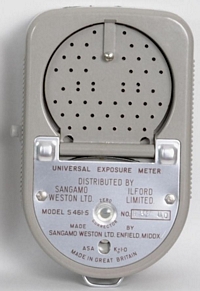| ILFORD Exposure Calculators & Meters |
|
|
|
|
I welcome information from anyone who can add to what is presented here. Essentially, Ilford marketed a very early multiple rotary disc exposure calculator manufactured in three main designs (see below), various forms of Actinometer, exposure tables, three selenium cell photo-electric exposure meters. They also acted as distributors for the S.E.I. Photometer and Weston Master selenium cell exposure meters. To view many early exposure meters, some similar to the ones illustrated and described here, take a look at Barry Levinson's impressively illustrated website. Barry lives and works in Israel. |
|
| Rotary Disc Exposure Calculator | |
|
For information relating to the ILFORD rotary disc exposure calculator I am indebted to Roy Phillips who once owned the aluminium version of the calculator (see below) and who provided the scan of the (maybe 1901) instruction booklet. I must also thank Richard W Holzman (who has previously assisted me with my Johnsons of Hendon and Wellcome Exposure Calculators) for his great expertise on all matters relating to exposure measurement. More recently Doug McKee has sent me information relating to announcements by the BRITANNIA WORKS Co.Ltd; Ilford, London (as Ilford Ltd was known, prior to 1901 - see Chronology) concerning the meter's availability and early manufacturing difficulties. The following chronological information relating to the Ilford Exposure Meter have been extracted by Doug McKee from issues of 'Photographic Scraps' a free monthly news sheet produced by the Britannia Works Co. Ltd (believed to have been printed from around August 1889). August 1st 1892. ..... The "llford" Exposure
Slide Rule or Exposure Meter, specially designed for use
with the various rapidities of "Ilford" plates, by
Professor A. J. Scott, of Dublin. Professor Scott is known as
one of the most careful investigators we have, and was the first
to give to the world the table of the varying actinic values
of light at different seasons of the year and hours of the day.
This table has been used by all writers, &c (sic; perhaps
this should read "etc") as the standard, and Professor
Scott has given the most careful study to the working out of
this exposure slide rule for us. It is based on the experience
of many years, and its efficiency proved by a long series of
actual tests. The instrument will be made in the most careful
and substantial form, so that it will bear handling, and will
be convenient for the pocket and, lastly, it will be more economical
in price than any exposure meter yet introduced. October 1892. It is approximately the same weight
and thickness, and can be as easily carried in the waistcoat
pocket, as a crown piece. Its value is intrinsically far greater
than that coin, and yet its price is only 5/-, post free 5/2.
Will be ready shortly. November 1892. We have placed the manufacture of these in the hands of a well-known Birmingham metal worker, and have had the first trial stampings from the dies. These please us very much, and the instrument promises to be even neater and better made than we expected. Six separate dies and stampings are used, and this, with the requisite fitting and finishing, necessarily takes time, so that we are not yet able to announce that the meter is ready. Before we do so, we shall get a considerable stock in hand, for the orders already received are numerous, and we do not want to put them on the market until we have sufficient to supply all demands, and thus prevent disappointment. December 1892. The manufacture of these is being rapidly pressed forward, and we are getting a stock in hand, as already advised. We hope another ten days or so will see them ready to be issued. The demand is much larger even than we anticipated, and the care bestowed on their production renders the output somewhat slow. February 1893. After spending three months in making these, the metal stampers have found aluminium too stubborn and variable to allow of a really uniform and high-class article being made from it. Brass, or any other metal, is too heavy, so that we have decided to make the meters in ebonite. This will necessitate new dies, new presses, etc., and we must therefore ask the indulgence of our friends for a little further delay. It will not be long. July 1st 1893. We have not said anything about this
instrument in our recent issues because we wished to have it
actually finished and ready for sale before we spoke of it again,
in order to prevent further disappointments from possible delays. |
|
|
As can be read above, although first announced in August 1892, due to manufacturing difficulties it wasn't available until July 1893, by which time its material of construction had changed from the originally intended aluminium to ebonite (one of the earliest forms of plastic). It was 3 inches (75mm) diameter, weighed 1 ounce (28.3grammes) and cost 5s (25p). Alongside is the meter in its ebonite form, made of black and red ebonite discs. By October 1893, the Brittania Works announced that the third 1000 had been manufactured ready for delivery. The instrument consists of three movable circles or discs, which revolve freely on a central pivot, and two fixed discs at the extreme rear and at the front. The front (fixed) disc shows information relating to the sensitivity to light of the plate or film in use. The next down shows information relating to the intensity of sunlight dependent upon the date (called the Date Circle - used in conjunction with the Date Table on the back of the meter - scroll down, see RHS). The third is the Diaphragm Circle relating to the lens aperture (i.e. f stop) in use. The fourth disc is the Subject Circle relating to the type of subject being photographed. The rear (fixed) disc is the Exposure Circle which shows the required exposure in fractions or whole seconds, minutes or (even) hours (!). This ebonite version proved difficult to use because the markings were not distinct. So the design eventually (1899) reverted to aluminium. |
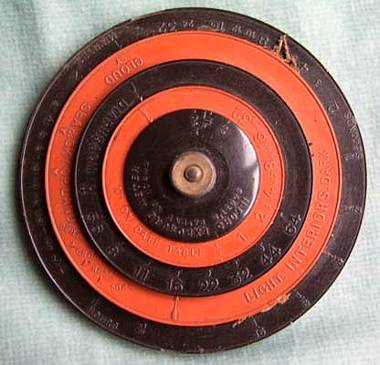 |
|
The Calculator was patented by Professor John Alfred Scott and John Howson of the Britannia Works (subsequently Ilford, Limited). The diagram alongside is taken from the original 1892 patent, which can be viewed as a pdf here. Richard W Holzman was surprised to see that the instruction booklet (see above) contains the name Professor A.Alfred Scott instead of Prof.John Alfred Scott. Richard believes this is the same man named as Dr.J.A. and John A. in various articles dating to the 1880 and 1890s, where he is associated with a table of comparative exposures. He had articles in the British Journal of Photography Almanac from 1886 for many years. Doug McKee reports that Richard is exactly right in his surmise that the inventor's name is wrongly given in the 1901 instruction booklet. |
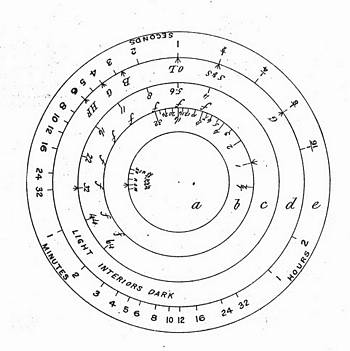 |
|
Doug has a copy of the same booklet but pre-dating the 1901 issue (see the two images, below). This correctly names Professor John Alfred Scott as the inventor. The error pointed out by Richard W. Holzman must have been a typing error in the newer reprint. As confirmation of the earlier date of the copy owned by Doug McKee (possibly 1893) notice that in the earlier copy the company name is the original 'The Britannia Works Co., Ltd', rather than (from 1901) 'Ilford, Limited'. The earlier version of the instructions also includes the BJPA review of the calculator, as can be read (in full) by clicking the hyperlink to the July 1893 'Photographica Scraps' magazine. The July 1893 announcement in 'Photographic Scraps' of the Rotary Disc meter and the full British Journal Almanac review, can be read here as a pdf (courtesy of Doug McKee). |
|
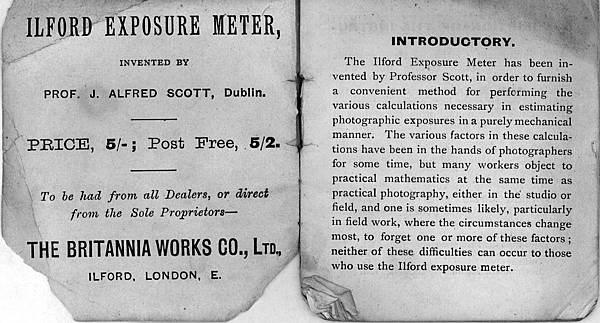 |
|
 |
|
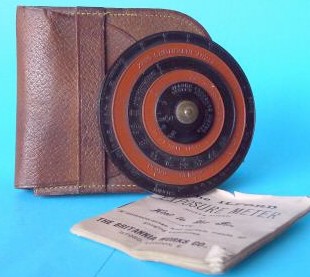 The 1892 meter, with its leather embossed case and instruction booklet, and its reverse (see right) showing the Date Table. |
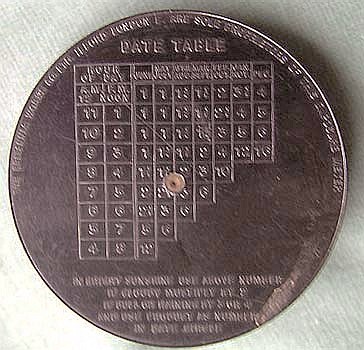 |
|
Roy Phillips owned the aluminium version which can be seen here, first introduced in March 1899.
|
|
|
|
|
|
Richard W Holzman reports that in 1906 a four disc version was on the market covered by a different patent (dated 1905) by Roland S. Potter, a research chemist at Ilford. This four disc version was available in aluminium (original price 5s = 25p) or heavy paper (price 1s = 5p; for picture, scroll further down) to at least 1929 and perhaps later. The original patent can be viewed as a pdf here. Doug McKee sent me a pdf of
the 1907 BJPA review, but now (March 2020) that BJPA entry has
been updated by scans from Richard W Holzman. To view as a pdf
click here. Simon Spaans has kindly sent me the scans below of his 4-disc aluminium calculator. |
|
 |
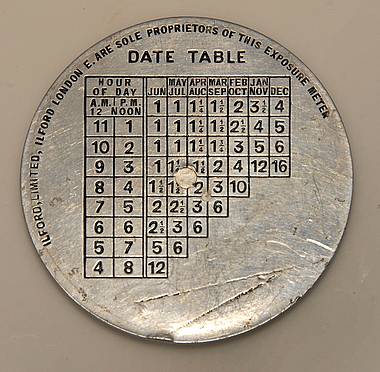 |
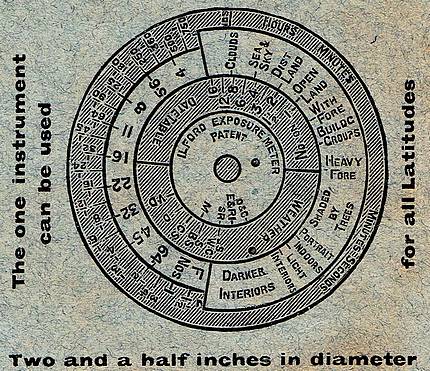 |
A scan by Simon Spaans of the inside rear cover of the 4-disc version instruction booklet. Notice that this version is 2½" diameter (63.5mm) rather than the 3" (76mm) diameter of the ebonite 5-disc version (see above). Simon says that "In the leather case for the disc, the (Dutch) owner had written a date: 5-2-1910, almost a hundred years ago!" |
| Further thanks
to Simon Spaans for the following images of the 1s (5p) heavy
paper (cardboard) version of the 4-disc calculator. It is 63mm
diameter. Notice that this 'paper' version probably dates later
than the Aluminium version above, by virtue of it having additional
Ilford plate type initials in the centre disc. It perhaps dates
to around 1920. The abbreviations are believed to refer to the following plates, though some inconsistency in these presumtions is present. O. & I. = Ordinary & Iso. Medium Rapidity (introduced 1885 & 1891 respectively; speed 4.5 ASA/ISO - post-1960 speed rating basis) C. = Chromatic (introduced 1897; speed 4.5 ASA/ISO - post-1960 speed rating basis) R. = Rapid (introduced 1885; speed 5.5 ASA/ISO - post-1960 speed rating basis) E. & R.I. = Empress & Rapid Isochromatic (introduced 1895 &1905 respectively; speed 9 ASA/ISO - post-1960 speed rating basis) S.R. & S.C. = Special Rapid (introduced 1895; speed 13 ASA/ISO - post-1960 speed rating basis) & Screened Chromatic P. & R.C. = (rapid) Panchromatic & Rapid Chromatic (introduced 1918 & 1911 respectively; speed 20 ASA/ISO - post-1960 speed rating basis) M. = Monarch ("Silver by the Ton" says introduced in 1903 as a 3.5 ASA plate and in 1906 as 35 ASA Flat Film ~ the 35ASA value is consistent with the position of 'M' at the fastest end of the speed range) |
|
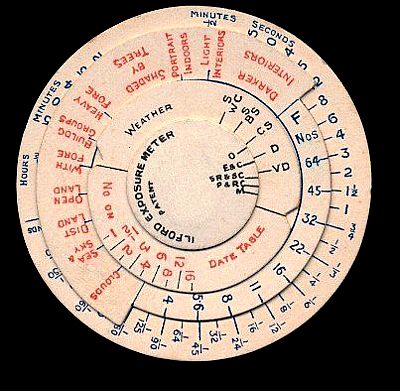 |
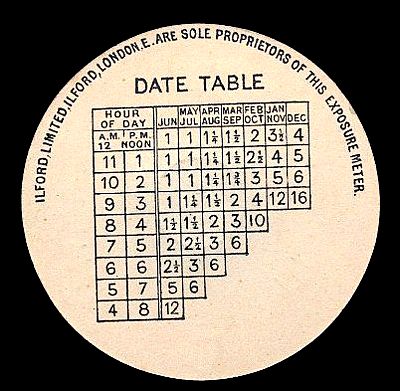 |
| More scans by Simon Spaans appear below. These show what appears to be an updated version of the Ilford 'heavy paper' 4-disc calculator, but now a part of the Royal Photographic Society's (RPS) diary (years unknown). It is 63mm diameter. Notice that film speed ratings are now in the Ilford designation of 'A' to 'E', suggesting the 1930s. The faster speed rating 'F' is believed to have first appeared post-WW2 and 'G' by the late 1940s. | |
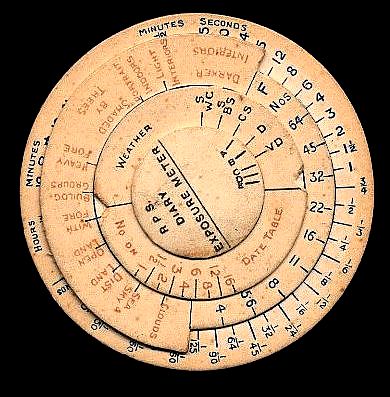 |
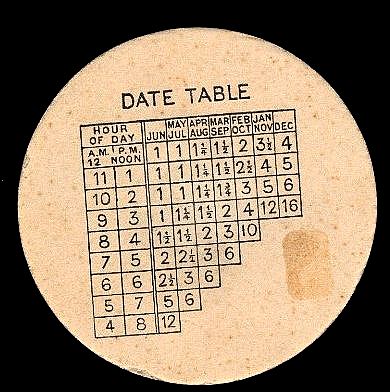 |
|
David Bayliss has been in touch (June 2017) to say that he also owns a card version of the 4-disc calculator, the same as the upper (earlier) of the two owned by Simon Spaans (above). He also has the instruction booklet and says: "Apart from ‘1907’ pencilled on the cover, presumably by a previous owner, the booklet is not dated. However it does advertise the Ilford Manual of Photography at 1s 0d, which might give a ‘before’ date. The booklet is applicable to the aluminium version AND the card version indicating that they were, at least for a time, being produced simultaneously". A scan of David's meter (kindly
provided by David) is shown to the right. Some of the pages of the instruction booklet can be downloaded as a pdf here. |
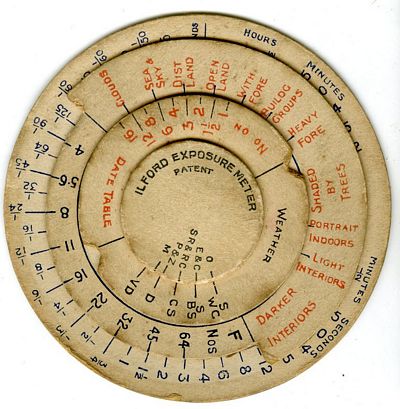 |
|
The Royal Photographic
Society's Diary for 1925 The Diary contained an exposure meter based upon the Ilford rotary disc design. The Preface ends "The Council desire to express their indebtedness to Mr. A. C. Banfield, F.R.P.S., and to Mr. Olaf Bloch, F.I.C, F.R.P.S.. for their invaluable assistance in contributing articles and to Messrs. Ilford, Limited, for the permission to use the Ilford Exposure Meter (from which it has been adapted) as the basis of the Diary Meter. The RPS diary can be viewed by downloading the pdf here, courtesy of Richard W Holzman. As far as is known, no other RPS diaries were published. |
|
| Imperial Dry Plate Co. Ltd Actinometers - marketed (1936) by ILFORD, Ltd | |
|
The following is taken from: For much of the story and the pictures (alongside and below) of the Imperial actinometers and exposure calculators, I am indebted to Richard W Holzman. The pictures alongside are the covers of two Imperial Dry Plate Co.Ltd handbooks for the years 1907 and 1910, both within Richard's collection. The Imperial Dry Plate Co. Ltd of Cricklewood, London, NW2, introduced an actinometer in 1901 as a card with an actinometer and calculator on one side and the instructions on the reverse. The original British Patent 3873 of 1901 can be viewed by clicking here. |
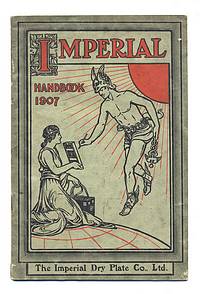 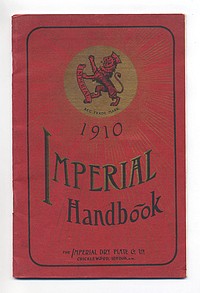 |
| An early version of this calculator (as defined by its film speed scale running only to 400 H&D), is owned by David Bayliss. The smart cover is coloured dark blue. | |
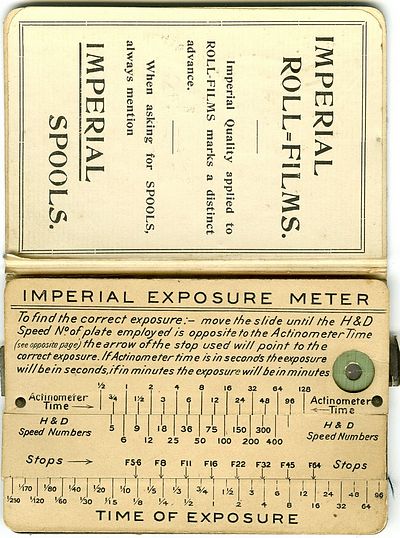 |
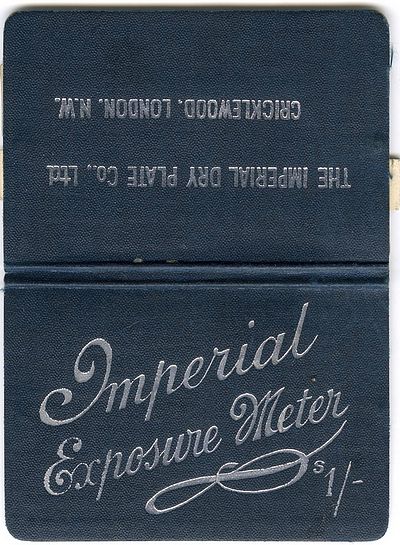 |
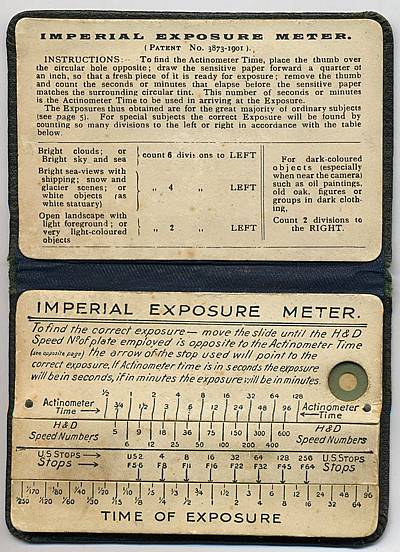 |
Left and below is a version produced somewhat later, the H&D scale runs to 600 and the two sides of the original card are mounted within a half-fold green wallet. Note the cover price of 1/- (1 shilling = 5p) |
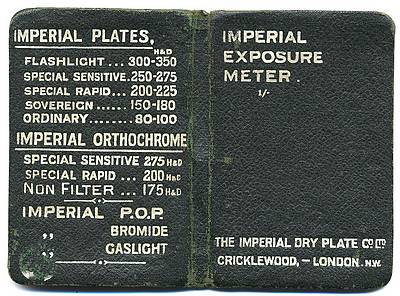 The reverse (i.e. cover) of the two cards shown left, can be seen above, but not to same scale. When opened up for use, as show above & left, it measures 140mm by 100mm. |
|
|
Imperial also introduced another device for exposure determination in 1901, called the 'Reckoner'. This was based upon a similar sort of sliding scale calculator as the actinometer (above) but exposure determination did not rely upon the actinometer method. It relied, instead, that most photographs were (still are) taken of 'usual' subjects under 'average' weather conditions, whereby a sliding scale calculator is adequate to arriving at an appropriate exposure. Hence, the need for exposing actinometer paper was avoided under these 'every day' photographic conditions. As with the original 1901 Actinometer, the first form of the 'Imperial Exposure Reckoner' was a double sided card, as shown below. These scans are of an 'Imperial Exposure Reckoner' sold for use in Australia, so the Table of Light Values is intended for latitude 30 degrees south! My thanks to the current owner, Andrzej Jablonski, for these two scans, front & back. |
|
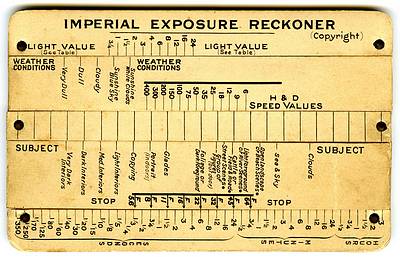 |
 |
|
By 1907, the 'Reckoner' had become a half-fold wallet (see below). This one has a red cover. It is likely that the actinometer version of the 'Imperial Exposure Meter' had also become a half-fold design by this time. For larger views of an early, and also a subsequent version, of the 1907 Reckoner, click here or the image below  |
The picture below, of a double
sided card version of the Imperial Exposure Reckoner (as the
one shown above) has been taken from the ebay auction site. Hence
its 'true' colour is unknown. 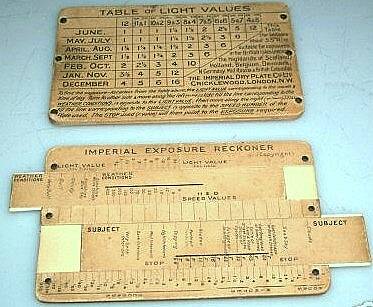 |
|
The British Journal of Photography for April 7th, 1911 (p270) announced the arrival of a second actinometer to supplement the original, with the new arrival being for use in Dull Light. The BJP announcement can be read here. The original was now renamed the 'No.1 for Bright Light' and the new was called the 'No.2 for Dull Light'. Individually, each was still priced at 1/- (5p). In the Shire book entitled "Photographic Accessories 1890-1970" by Robert White, the No.1 for Bright Light is shown in a red cover and the No.2 for Dull Light is shown in a green cover (p28). However, a No.1 owned by Richard W Holzman has a green cover (extreme right). The cover colours of the other illustrated versions has been stated, see their adjacent text, but there seems no consistency. The light sensitive paper used by the actinometers was the same for both the No.1 and the No.2 meters, the difference was only to do with how dark the paper needed to become in order to indicate the correct exposure. The colour comparison disk, surrounding the hole through which the light sensitive paper was exposed to light, was lighter coloured in the No.2, such that the paper did not need exposing to dull light for an excessive time in order to achieve a colour match. |
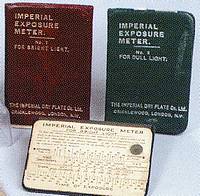 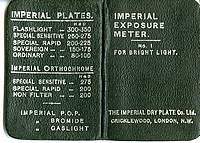 |
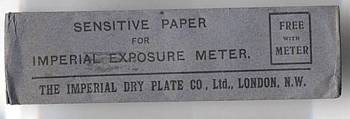 |
|
|
A pdf of the Instruction Booklet
for the No.1 can be downloaded here or click on the icon. A pdf of the Instruction Booklet
for the No.2 can be downloaded here or click on the icon. |
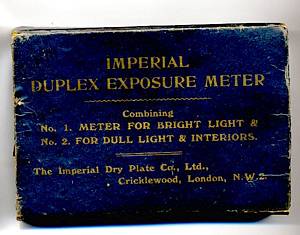 |
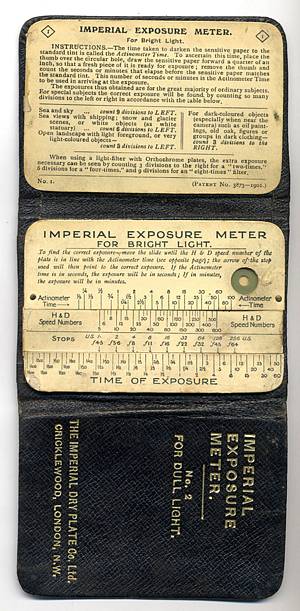  |
  The Duplex opened to show the Dull Light actinometer (and the No.1 Bright Light cover) |
|
The British Journal of Photography for March 14th, 1913 (p213) announced an Imperial 'Combined Meter' which consisted of the No.1 'For Bright Light' actinometer and the Reckoner in a three-fold case. The announcement can be read here. The price, including instruction booklet and light sensitive actinometer paper, was 2s/6d (12.5p). Richard has seen a red covered 'Combined' (perhaps like the one shown below, owned by David Bayliss. The idea being that the exposure for most average subjects could be assessed using the Reckoner without need for exposing light sensitive paper in the No.1 actinometer. But the actinometer was there in case the photographer met unusual conditions which he wasn't confident he could assess using the Reckoner. "The new imperial meter fulfils the conditions in both cases". |
|
|
David Bayliss (see his very early Imperial Exposure Meter above, near the top of this section) has now (June 2024) sent the pictures to the right and below, showing a nice maroon bound example of the Imperial Combined Exposure Meter and Reckoner, which consists of the 'Imperial Exposure Reckoner' and the 'Imperial Exposure Meter No.1 For Bright Light'. The Reckoner and Exposure Meter are all bound together in a similar fashion to Imperial's Duplex Meter. The right hand picture shows the Meter, the original box, the instruction booklets and the light sensitive paper, which is used to assess the lighting level when the Table of Light Values is insufficient guidance. Usually, in bright light, the use of the light sensitive paper is unnecessary. The two pictures below show how the single triple fold 'book' could be opened to reveal either the No.1 Imperial Exposure Meter for Bright Light or the Imperial Exposure Reckoner. The red front covers on the pictures below seem to contradict the two white pages that are alongside. However, that is to do with how the triple foid is arranged. In use, when either red cover is opened, the two white pages that are revealed are the ones on the 'other' side of the ones in the pictures below - hence correctly corresponding with the red cover. In the bottom left hand corner of the two instruction booklets shown to the right, are the numerals '619' (Exposure Reckoner) and '1020' (Exposure Meter). These are believed to stand for June 1919 and October 1920, respectively. David comments how the booklets are over-stamped 'Prices Advanced', possibly a subtle way of saying 'Prices Increased'. |
 |
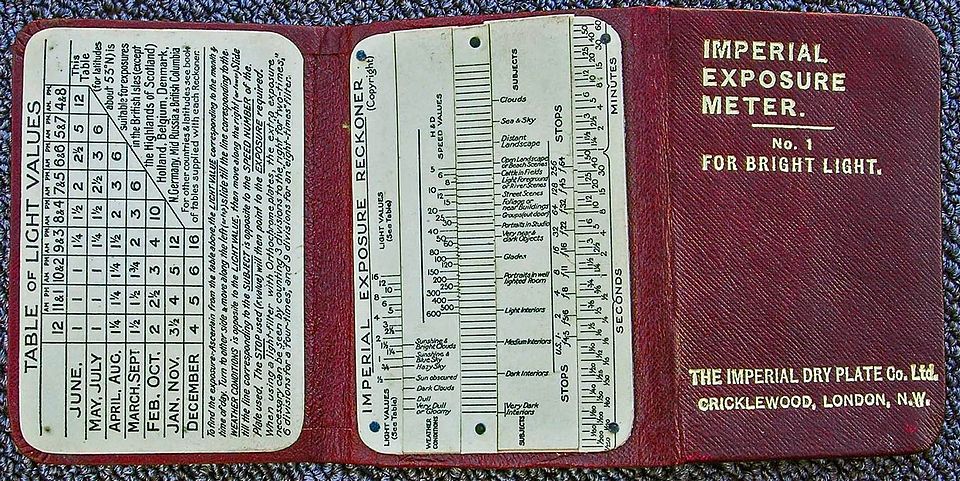 |
|
|
|
|
|
The Imperial Dry Plate Co.Ltd of Cricklewood, London, NW2, came under Ilford Ltd control during the period 1918 to early 1930s when many of the smaller UK photographic firms amalgamated with the larger organisation. See the Ilford Chronology, 1930, for more information, but it is imprecise. The British Journal of Photography (BJPA) for September 1936, page 18, says "Users of the well-known Imperial exposure meters and reckoner, will now find them under the name of Ilford, unchanged in principle or appearance, but carefully brought up to date and adjusted to give absolutely uniform and reliable results under all conditions. Those who use 'sensitive tint actinometers' will find these meters - one for bright light, and the other for dull light and interiors - most convenient and reliable. The price is 1s/6d (7.5p) for either meter or reckoner, or 3s/6d (17.5p) for the Duplex meter combining the two single meters." Left (below) is one of the original Imperial Exposure Meters and to the right is the Ilford equivalent, post-1936. This scan has been sent to me by Jeff Gould. The largest f-stop has been extended from f4.5 to f2.5, and the film speed range is increased form H&D 600 to H&D 6,000. |
|
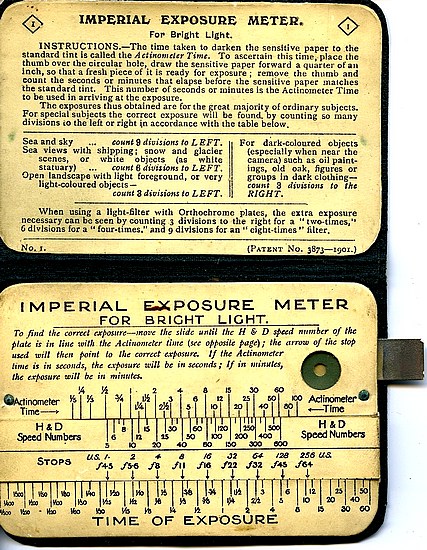 |
|
|
|
|
|
Richard W Holzman comments that the 1936 Ilford versions of the Imperial actinometers may not have been sold for long as he has never seen any apart from the photograph shown alongside, taken from Photographic Science & Engineering (PS & E) magazine for March / April 1959, page 79. Interestingly, although this one should be the same as the No.1 Bright Light version sent to me as a scan by Jeff Gould, see above, the one that was pictured in the 1959 PS & E magazine has a film speed range that only runs to H&D 1200, rather than H&D 6,000. The f-stop range is the same, running from f2.5 to f64. So the PS & E version seems to 'sit' between the earlier Imperial No.1 Actinometer and the Ilford No.1 owned by Jeff Gould. Perhaps the one owned by Jeff is a later version, when film speeds had been extended, whereas the PS & E image is a true 1936 example ? H&D 6,000 corresponds to the Ilford film speed Group G, which didn't appear on Ilford's selenium cell exposure meters until the Model C in 1949 (see below). If this is the case, then the Ilford actinometers were presumably sold for at least 13 years, from 1936 to 1949, and perhaps into the early 1950s. |
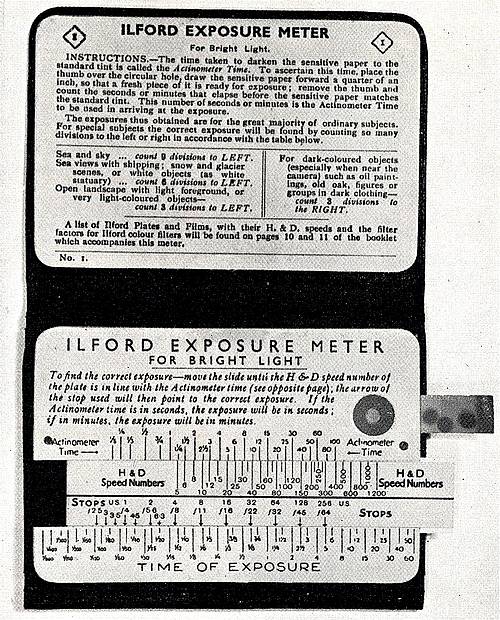 |
| 'Selo' Exposure Card | |
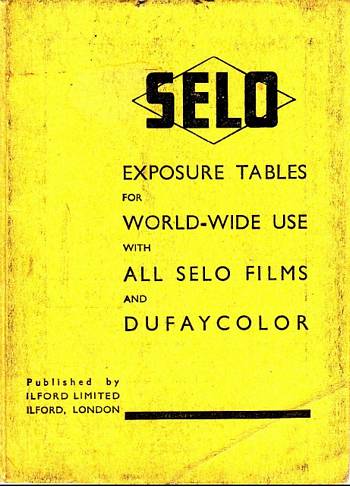 |
In the same 1936 BJPA reference as above, the text continues: "Messrs. Ilford have also issued a Selo speed card, which gives the daylight speed of all Selo films in DIN, Scheiner, H&D (English & Continental), Weston, Burroughs Wellcome, and Justaphot. All who use Selo films should secure a copy of this card." Richard W Holzman has kindly supplied me with a pdf file of this card, the front cover of which can be seen left. To download the pdf, click here or on the cover image. The footnote on the final page reads 'K 36', implying November 1936. |
|
Although not strictly an exposure calculator, the 'Ilford Exposure Tables' booklet is included for completeness. Unlike the Selo card, above, these Tables require no calculation in their use. The booklet is simply a collection of tables showing (directly) the recommended exposure under a wide range of conditions and times. Richard W Holzman has supplied me with scans of all the pages which make up the Tables. The cover is shown (far left) and below is an example of the pages. A full version can be viewed as a pdf by clicking here or on the image left. A footnote on page 1 (A 34) suggests these Tables date to January 1934. |
|
|
|
|
| Of course, Ilford, like all other film manufacturers, included very simple exposure guides packaged with each film. For an example, click here. | |
| ILFORD photo-electric exposure meters (made by AVO) | |
|
There were three of these meters, all physically similar but with their chronology traceable by the Ilford Speed Group lettering system. The first meter had speed graduations A-E (4-64ASA), the second, Meter B, was also initially marketed with A-E but subsequently its speed range was extended to the range A-F (4-125ASA). The third, known as Meter C, had A-G (4-250ASA). The instruction booklet for the Meter B indicates that the film range A-E was later extended to include the speed rating 'F' due to the increasing speed of Ilford's Hypersensitive Panchromatic plates and films. The Ilford Speed Group system was eventually extended to cover A-H (4-500ASA) in order to include their fastest emulsion (one time fastest in the world) HPS, from 1952. Richard W Holzman confirms that these meters were made by the UK company known as "AVO" (previously known as the Automatic Coil Winder & Electrical Equipment Co. Ltd; ACWEECO; started in 1923). In 1937 their address was Windsor House, Douglas Street, London, S.W.1. Andy Gilham, one of the mechanical
designers at Megger
Instruments Limited, Archcliffe Road, Dover, Kent CT17 9EN,
the company that was formerly AVO Ltd, has e-mailed (November
2016) to tell me that AVO moved to Winder House in 1930, having
previously spent a short time at Rochester Row, London, and before
that in Wellington House, Buckingham Gate, London (where the
company began). Further from Andy Gilham (April 2020) is that the original Avo Exposure meter was launched in 1935, based on design patents by Hugh Sutherland Macadie. The design was cased in a Bakelite housing that very much resembles the Avometer at the time, with the ‘kidney dish’ shaped window. Avo dropped this housing style for the Exposure Meter Model 2 the following year and Ilford continued using it, but still manufactured by Avo/ACWEECO. Andy is sure, from the dismantled view of the Ilford Model A (see below) that it is of Avo/ACWEECO style. He derives this from the design of the 'movement' and more importantly the serial number on the scale plate, which reads 1361-86. This instrument was manufactured in August 1936 and it was 1361 instrument to be sold (in total). The date is in the last 2 digits (86). The first digit is the month (August) and the second is the year, where the decade is implied (1936). |
|
|
Meter A (not its official name, but used here to distinguish it from the later photo-electric Meters B and C, below) was marketed from 1935. The 1936 BJPA article,
page 291, (click here for a pdf original) reads: |
|
 |
The meter had a leather case with wrap-around twin press-stud closers. The instruction book is available to view as a pdf, courtesy Richard W Holzman. This issue of the instruction book is code dated H 35, meaning August 1935.
The high quality scans of Meter A shown below are all courtesy of Richard. |
 |
Note the green, black & red arrows on the outer disc and the similarly coloured scales in the meter needle window. Their mode of use is explained in the Instruction book (see above) and also referenced in the brief instructions, below. The Ilford Speed Group lettering scale from A to E is clearly visible (see left). |
|
He comments "The three ranges on the meter are accomplished by means of a fine wire wound rheostat connected to the outer dial." The rheostat slider can be seen at the bottom of the picture. From the number on the exposure scale, Andy Gilham (of Megger Instruments - see his further information in the opening paragraphs above; ILFORD photo-electric exposure meters - made by AVO) can see that this instrument was manufactured in August 1936 and it was the 1,361 instrument to be sold (in total). The date is in the last 2 digits (86). The first digit is the month (August) and the second is the year, where the decade is implied (1936). |
|
|
|
Brief 'reminder' instructions for use are moulded into the back of the (presumably) Bakelite casing of the meter. They are transcribed here: INSTRUCTIONS: |
|
"AVO", the makers of the Ilford exposure meters, advertised their own design around the same time that the first Ilford meter went onto the market. The one illustrated below is being sold at the same price as the Ilford version. For more information on the AVO company (now Megger Instruments), scroll up. To view pictures of an early AVO meter owned by Ian Grant, and download its instruction manual, click here. |
|
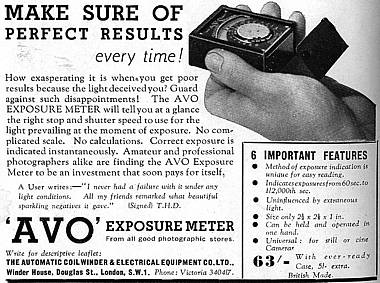 |
This advertisement is taken from the October 1937 issue of The Miniature Camera Magazine (inside front cover, pii). Although with some physical similarity, it is not the same. Interestingly, the Miniature Camera Magazine for August 1937 may carry the first mention of an exposure meter working on the incident light basis of exposure measurement. The research for this technique is ascribed to Mr.P.C.Smethurst who called his invention the 'high-light' method. It was first described in the Amateur Cine World magazine. Mr Smethurst and AVO got together on this and AVO produced a meter called the "Avo-Smethurst High-Light Meter" ~ see the insert in the right hand advert here. The Avo-Smethurst differed from the conventional AVO meter by having an opal glass plate immediately in front of the photo-cell. It appears this was a permanent feature, not detachable as became the norm with e.g the Weston Invercone, enabling the same meter to be used for both reflected and incident light readings. |
| Meter B This was the second Ilford photo-electric exposure meter and was named by Ilford as Model B. The Model B was sold from mid-1937 until it was replaced by the Model C in 1949. |
|
|
|
Shown here are two versions, an early one (see left - courtesy of Richard W Holzman) which bears the Ilford Speed Group letters A-E (as the Model A), and a later version (see below, maybe post-WW2) which bears the Ilford Speed Group letters A-F. The later version has lettering which is far more visible than the earlier version. The original instruction booklet
(on its page 8) shows that, even at the time the booklet was
produced (March 1938), the Ilford The Model B was a dual range meter, having a red dot and a green dot. The method of use was to align the appropriate dot with the meter needle (not visible in the picture, below). To assist with this, there are raised lines in the casing between the central dials and meter window which align with the marks on the meter scale. An internal baffle plate moved in front of the cell (internal the meter's casing) when the red dot was used. The meter was reviewed in the British Journal of Photography (BJP) for July 23rd 1937, p474 and the text is transcribed below the pictures - click here for a pdf of the original article. The original text of this article has some errors which confuse the method of use of the meter, so below I have added (in parenthesis) my understanding of what was actually meant. |
|
|
This is the box in which the early version (as above) of the Ilford Photo-Electric Exposure Meter Model B was packaged for sale. Picture courtesy of Doug McKee. The paddle steamer logo is the last version used, phased out during 1945, prior to the Model B meter update shown below. |
 |
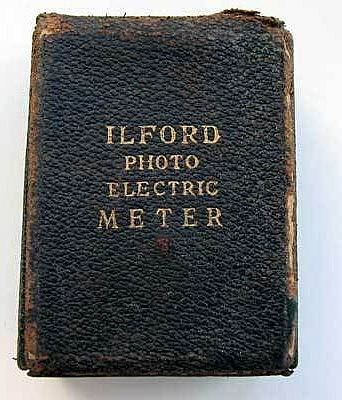 |
| Ilford Photo-electric
Exposure Meter Model B. Sold by Ilford Limited, Ilford, London. This meter is a considerably improved form of the original Ilford photo-electric exposure meter which has been available for about two years now. In outward appearance it looks rather similar to the previous model, but on examination it can be seen that certain changes have been made. The engraved dial which carries the stop numbers and shutter speeds is somewhat different; it now carries two sets of exposure figures, and also a red and a green dot. One range of shutter speeds is from 100sec to 1/100sec, and the other shows exposures between 1/2,000sec and 2sec; each of these scales occupies less than half of the dial, as can be seen. The fixed centre boss of the meter dial carries the letters A, B, C, D, E, which are the five speed groups (from slow to fast) into which all the Ilford emulsions are divided for the purposes of classification for setting the meter to the speed of the film or plate in use. This is done with the arrow shown, and on the same disc as the arrow are engraved the stop numbers from f/1 to f/32. When using the meter, having already set it for the film in use, it is merely necessary to point it at the subject and note the position of the small red-headed pointer. Keeping it pointing thus at the subject, the outermost scale is then turned with the thumb, which is pressed against its finely knurled edge. The green and red dots, which have been already referred to, now come into play. If the light is intense, as in fairly bright outdoor subjects, the green (should read red) dot is moved so as to come opposite the marks on the moulded casing which correspond to the graduations on the scale over which the pointer moves. When so set, the correct exposure can immediately be read on on the dial for all stops. Conversely, the green dot is used for more dull subjects, so that if a reading cannot be obtained, owing to weak conditions of light, the outermost disc is turned until it brings the green dot into the range of indicating marks. At the same time, the other set of shutter speeds is brought into place against the f/-numbers. Turning the outer scale in this manner so as to change from the green (should read red) to the red (should read green) indicating dots operates a swinging diaphragm over the cell itself inside the meter. When working with the red dot only a small hole, about 1/10" in diameter, is left in front of the cell, through which the light can shine; changing over to the green one uncovers the whole of the cell to the light. The photo-electric cell is set well back inside the meter, which thus narrows its acceptance angle; this helps to produce more accurate reading owing to the elimination, as far as possible, of stray light which is not part of the subject. The swing-in stop takes up its position automatically, just behind the cell window, and is some distance in front of the actual cell; the whole of the cell is thus still used, but the quantity of light reaching it is diminished. The meter is very sensitive, but is, at the same time, robustly constructed. It is in a case of black moulded material, the under side of which has a panel which bears very brief instructions on the use of the meter. A complete instruction booklet is provided, and this explains the operation of the meter in detail, and in addition gives a full list of Ilford films and plates classified under their speed group letters. Another useful application of the meter, where a direct reading of the subject is not possible due to there being too low an illumination level, is the method of measuring the exposure necessary for the light source and multiplying by a suitable factor. A method of highlight exposure measurement is also described which is particularly well adapted for the exposure of reversal cine film. The llford exposure meter Model B, which is supplied complete in a strong and neat ever-ready type of leather case, costs £3.3s.0d |
|
| Meter Model C | |
|
The picture below is of a 1949 Meter Model C (picture provided by David Muggleton). The Ilford Speed Group lettering A to G is now accompanied by an Ilford Scheiner logarithmic speed rating. The instruction booklet says "the latter, which have frequently been referred to as European Scheiner degrees, are approximately one unit higher throughout than the corresponding B.S.I. logarithmic exposure indices". This meter is single range, each Light Value on the scale under the meter window being twice the brightness of the previous numbered Value. The Light Value appropriate to the subject is read off from the meter needle indication and transferred to the central scales for calculating exposure. At this time, HP3 film was only a speed rating of 125ASA (Ilford Letter F, Scheiner 32) presumably to maintain sufficiently fine grain within small negatives. Plates, being larger and hence requiring less enlargement, were faster, being Ilford Letter G, Scheiner 35. |
|
|
Scroll down to read the 1949 BJP and 1950 BJPA reviews The original instruction booklet for the Meter Model C can be viewed & downloaded as a pdf by clicking the picture.  |
|
| The Model C was
reviewed in the British Journal of Photography (BJP) for September
2nd 1949, p414. The text is transcribed below - click here for a pdf of the original article. |
|
| The Ilford Photo-electric
Exposure Meter (Model C). Ilford Ltd., Ilford, London. This new Ilford meter is of the general type to which most photo-electric meters conform: that is to say, it comprises a black plastic case 2in by 2¾in by rather under l¼in thick, which is held horizontally in use, the photo-cell being deep-set, giving an acceptance angle corresponding to that of a reasonably wide angle camera lens. Exposure calculation is effected by a single disc, the "feel" of which is quite as good as any we have met, being very easy running and with just enough milled edge projecting for "thumbing" round but not enough for accidental turning. This meter is of the type in which an arbitrary light value number is indicated by the pointer, and this number is then set against the speed of the material on the disc, the exposure then being read off direct, on the same disc, against any stop from f1 to f/32. The scales are in very clear white-filled engraving that shows up brilliantly in any light against the black of the case. We would like to observe, at this point, that -purely a personal preference this, but one to be considered- we like the type of meter wherein the film speed is first set (being the one thing that will not need to be altered until the camera is reloaded) and the exposure then indicated direct at the moment of reading without further adjustment. A small point this, but we have in practice found it a great convenience when light is fluctuating and speed of operating may be important, as in colour work, where a sudden thickening of cloud may turn success to failure. This is not a double-range instrument: its single scale, apart from the lowest readings, is almost uniform and covers a total range of light values from 6,000:1. The scale covers exposures from l/2,000th sec to 1 minute: stops f/l to f/32, and film speeds 17 degs. to 35 degs. These are on the Ilford scale, and are approximately 1deg higher than B.S. (logarithmic) numbers. Ilford A - G groups are also engraved on the disc. We should like to give a word of praise for the instructions issued with the meter (we hope purchasers will take the trouble to read them: they are quite short, and very clear). Apart from the straightforward instructions in the ordinary use of the meter, an explanation is given of the blotting paper highlight method as applicable both for reversal materials and for dull lighting conditions; the same method is extended to artificial light, and factors are given for the three principal classes of material viz: hyper-pan, normal pan, and ortho; and for very dim artificial light, the light source method (pointing the meter direct at the principal light source) is given, again with the appropriate factors. It is our experience that even if users of meters know of these methods they rarely remember the necessary multiplying factors without which the methods are useless. A table of recommended settings for Ilford films and plates is given, each material bearing in addition a designation (HP), (NP), or (O), according to type, for use in artificial light. Finally, on the back of the instrument, factors are given for the conversion of the "light values" read directly from the pointer into illumination foot candles. Unfortunately, according to our tests, these values are not correct: the illumination values so obtained are approximately twice the true intensities. No doubt this will be corrected, and it does not, of course, affect the use of the instrument as an exposure meter. As regards the quality of the instrument the purchaser need have no doubt. It has a well-balanced movement, and is clearly a micro-ammeter of high precision. It is not quite as sensitive as our own favourite meter, giving about one-third the deflection at minimum readings. Since the first division of the scale is intended to represent a definite reading (nominally 1 foot-candle of illumination), we think there should be a zero index line, since however well balanced the movement, just a few degrees tilt downwards is sufficient to upset the accuracy of these very small readings; and no zero adjustment is provided so we hope the movement is completely free from zero creep. As it is, the first division really means nothing, unless it is to be assumed that the meter must be held dead horizontal. We hope that the few minor improvements we have suggested will be adopted in later series of this very excellent little meter. The price is £7 18s 6d, (£7.93p) complete with neck cord. |
|
|
Review taken from pages 226-227 of The British Journal Photographic Almanac, 1950. THE ILFORD PHOTO-ELECTRIC
EXPOSURE METER (Model C) (Ilford Ltd., Ilford, London) |
|
| ILFORD Ltd SEI Exposure Photometer | |
|
The S.E.I. (Salford Electrical Instruments) Photometer was distributed by Ilford Ltd. from 1948 and (in the U.S.A.) by The Zoomar Corporation. Clicking the following link takes you to a 'Shutterbug' web page written by Roger Hicks in October 2002. Roger fully describes the S.E.I and I will not repeat his work here. Essentially the Photometer is a comparative method of light intensity estimation, whereby a standardised light intensity, created by an internal lamp, is matched by eye to the light intensity of the subject. It works over a narrow angle of view so can take very detailed 'spot' readings. It can be a very accurate, but slow, exposure metering process. My thanks to Huw for displaying the SEI instruction manual and repair manual on his website. Newnes Photographer's Pocket Reference Book, published in 1955, contains (page 70) a description of its method of use. |
|
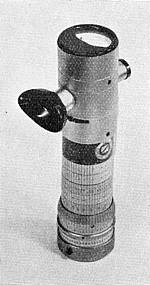 ILFORD LTD.; S.E.I. Exposure Photometer;
EXPOSURES FOR GENERAL PHOTOGRAPHY ILFORD LTD.; S.E.I. Exposure Photometer;
EXPOSURES FOR GENERAL PHOTOGRAPHYWorking Instructions.- To determine camera exposures for making negatives in general photography, the following working instructions should be followed. Setting the Speed Scale.- For ordinary black-and-white negative-making, set the black index mark on the narrow knurled ring opposite the appropriate number on the speed scale. The meter is graduated in British Standard Logarithmic Exposure Indices. An appropriate allowance must be made for any factor known to reduce the effective film speed, e.g. the use of certain fine-grain developers, a shorter development time than that normally recommended, stale film, working by artificial light, etc. Lamp Intensity.- To standardise the lamp intensity, press the black switch button in the broad knurled ring at the bottom of the instrument. Note the position taken by the pointer of the microammeter at the top. Make the pointer coincide with the standard mark by turning the recessed rheostat control, which will be found at the lower end of the barrel of the instrument. Release the switch button after standardising. For ordinary purposes the "standard brightness" setting accuracy need not be too great. A setting above the red mark by one-tenth of an inch causes an increased exposure equivalent to about one-third of a stop, and vice versa. The slight drift of the microammeter pointer is due to the unavoidable drop and recovery of the battery voltage and can be minimised by keeping the switch button depressed only for the short time necessary to obtain the required brightness match. Setting the Colour-of-the-light Corrector.- If working by daylight, set the knurled disc which is found under the eyepiece of the telescope so that the white index mark is immediately under the telescope. If working in ordinary artificial light, set this disc so that the yellow index mark is under the telescope. Viewing the subject.- From the camera position look through the telescope at the scene to be photographed. Focus the eyepiece to your individual eyesight by sliding it along the barrel of the telescope. The object lens also may be moved outwards if necessary for close work, but for ordinary use it should not be withdrawn. To orient the spot, make the black photometric spot in the middle of the view coincide with the image of the darkest part of the scene in which detail is required. Press the switch button again and try to make the spot match the part of the scene selected by turning the broad knurled ring. If the spot is always too dark or too light the subject image must be darkened or brightened by turning the knurled disc to the appropriate range so that the photometric spot can be matched. This knurled disc will be found to carry three coloured index marks. One of these is to be set immediately under the middle of the telescope objective as follows : For bright areas use the blue index mark. For normal areas use the white index mark. For dark areas use the red index mark. When bright areas are viewed and the blue index mark is in use, the shield round the eyepiece of the telescope must be close to the eye. In very bright light additional shielding with the hand above the eyepiece may also be helpful. Time of Exposure.- Read the time of exposure on the appropriate scale in relation to the f/number scale, taking care to select the exposure time scale of the same colour as the index mark used for the operation described in the previous paragraph. |
|
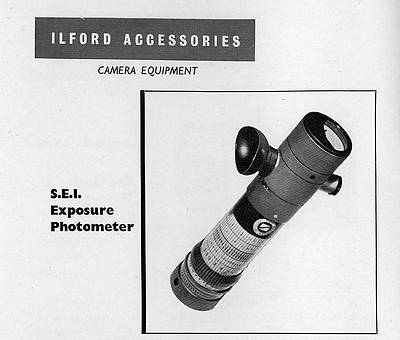 Text and Pictures from Ilford's 1952 General Catalogue Section Eight-B: Accessories for Professional Photography |
S.E.I. EXPOSURE
PHOTOMETER Price: £36 0s. 0d The S.E.I. Photometer is an extremely versatile scientific instrument for the precise determination of photographic exposures, brightness values, and, in conjunction with the accessories described on page 9, for the measurement of transmission and reflection densities. The photometer has a brightness range of 1:1,000,000 and readings can be made at a distance over a very narrow angle of view (½°), thereby enabling exposures to be calculated precisely by the brightness range method. It is suitable also for measurement of printing exposure times. The instrument has its own comparison lamp illuminated by a battery contained in the body, and a standard brilliance is controlled by means of a microammeter with rheostat control. Colour and neutral density filters are incorporated to allow for different types and different strengths of illumination. Exposures can then be read off directly in terms of shutter speeds and lens apertures whilst two other scales are calibrated in log foot-lamberts and relative density respectively. Alternative settings are provided for the measurement of exposures in general photography by the shadow method or for exposures in reversal processes by the highlight method. A leather carrying case with shoulder strap is available. Price £4 I5s 3d (£4.76p) |
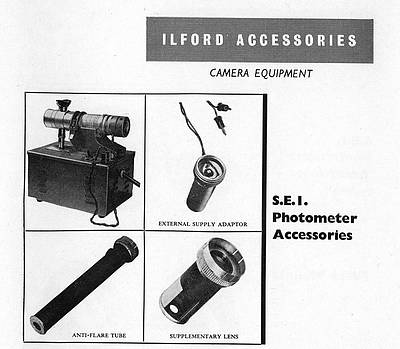 |
S.E.I. PHOTOMETER
ACCESSORIES These accessories, except the anti-flare tube, convert the S.E.I. Photometer into a densitometer for transparencies and reflection images. DENSITOMETER ILLUMINATOR Price: £8 5s. 0d (£8.25p) A box on which the photometer may be clamped. A panel of opal glass on the top diffuses light from a bulb contained in the box, the distance of the bulb being variable according to the brightness of the illumination desired. The bulb is fed from a built-in transformer and tappings are provided to work the external supply adaptor described below. Dimensions 9 x 9 x 6 in. EXTERNAL SUPPLY ADAPTOR Price: £3 12s. 0d (£3.60p) Converts the photometer for mains operation, in conjunction with the densitometer illuminator. It consists of a tube to fit inside the body of the photometer, and carries a lamp to illuminate the comparison spot. This lamp, and that in the illuminator, are fed from a parallel circuit to ensure equal relative output. SUPPLEMENTARY LENS Price: £3 6s. 0d (£3.30p) For making density measurements. An extension tube is fitted with a lens at one end and at the other a diaphragm to limit the field of view. A cut-away window is provided for use when measuring reflection densities. ANTI-FLARE TUBE Price: £2 2s. 0d (£2.10p) Reduces flare in the optical system when reading close to a highlight area of great illumination. A diaphragm at one end limits the field of view. |
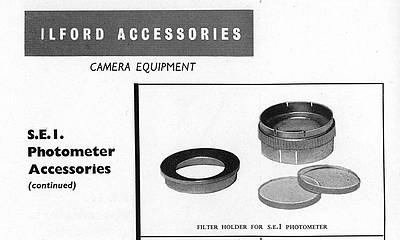 |
FILTER HOLDER
FOR S.E.I. PHOTOMETER Price: 19s. 0d (95p) A holder made from satin-chromed brass for use with colour or neutral density filters. The filter - ½in (12.5mm) diameter - is held by the push-on front element of the holder. Supplied complete with two clear glass discs. |
| ILFORD Ltd distributors of the Weston Exposure Meter | |
| To read about
Edward Weston, who pioneered the Weston series of exposure
meters, click here. He was born in the small town of Oswestry, in Shropshire, UK, in 1850. |
|
|
British Sangamo was founded in 1921 as the United Kingdom subsidiary of the "Sangamo Electric Co." of Springfield, Illinois, USA. They initially manufactured integrating kilowatt hour meters and later expanded their activities to include industrial time switches. In 1936, British Sangamo acquired the "Weston Electrical Instrument Co." of Surbiton, Surrey. This company was the UK subsidiary of the "Weston Electrical Instrument Corporation", of Newark, New Jersey, USA, a company founded by Dr. Weston (a pioneer in the field of electrical measurements), and recognized as one of the worlds leading manufacturers of electrical measuring and associated equipment. A detailed history of the Weston company is available here (click on 'About', top of left hand side list). The two companies were combined to form "Sangamo Weston", which designed and manufactured a wide range of electrical measuring and control equipment. Amongst these were the famous selenium cell Weston Master Exposure Meters. Sangamo Weston Limited were based at Great Cambridge Road, Enfield, Middlesex, N.London, about 10miles North East of Ilford, so it perhaps makes geographical sense (though possibly just coincidence) that Ilford Ltd became UK distributors for Sangamao Weston Master exposure meters from the Weston Master 1 in 1947 (reviewed in the BJPA for 1948) through to the Weston Master 5, starting in 1963. IIlford's main involvement seems to have been in distribution and advertising. However they did provide additional accessories, like cases. It's possible Ilford were not involved with the earlier Westons because they had their own range from Avo (see Ilford meters 'A', B & C, above). Doug McKee has kindly sent
me the following images. |
|
|
|
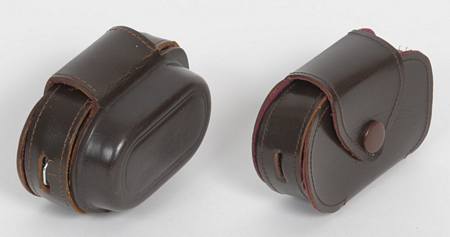 Two Ilford branded cases for the Weston Master II. The slimmer case (right) for just the meter (see below, right) and the larger to accommodate the meter and its incident light invercone and baffle (below, left). |
 |
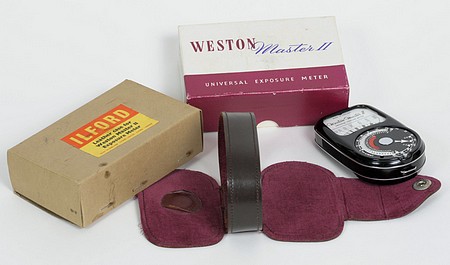 |
| |
|
|
Richard W Holzman has informed me of yet another Ilford exposure meter, though this one (best we know) never went into production. Our only knowledge of it is from its GB Patent 634,831 with an original application date of 17th December 1947, a 'date of filing complete specification' of 16th December 1948 and a 'complete specification published' date of 25th March 1950. The novelty claimed by the patent was for a photo-electric exposure meter constructed on a design similar to a wrist watch with the intention that it would be worn on the wrist for convenient use without needing to be hand-held. The joint proposers were Geoffrey Bond Harrison and Ilford Ltd, both of 23 Roden Street, Essex, UK. The patent can be viewed here. The idea of a wrist mounted exposure meter was not, in itself, novel. The novelty was in the use of a photo-electric cell within such a design. Previous wrist mounted meters were of the 'Visual' type; 'Visual' meters are pointed towards the subject and the user looks through the meter and views a series of letters or numbers behind an increasingly opaque (semi-transparent) screen. The letter or number that is just visible is used to indicate the amount of ambient light falling on the subject and, hence, the exposure required. The Ilford patent referred to a true photo-electric exposure meter, with rotating scales forming the 'watch' face of the meter and providing means to calculate the exposure based upon the needle movement of a microammeter. It is unknown why this wrist-mounted meter never went into production. Perhaps 'AVO', who made Ilford's meters, did not consider it a viable concept. |
|
|
|
|
|
|
|
 Richard has partly dismantled a Meter
A to understand how its triple sensitivity range worked.
Richard has partly dismantled a Meter
A to understand how its triple sensitivity range worked. Weston Master 1 (left) and Weston Master 5
to the same scale.
Weston Master 1 (left) and Weston Master 5
to the same scale.